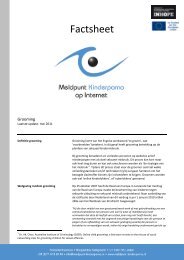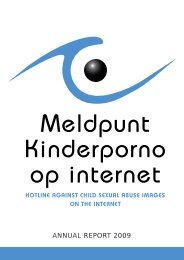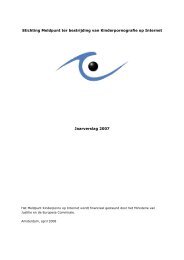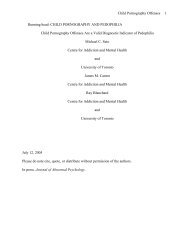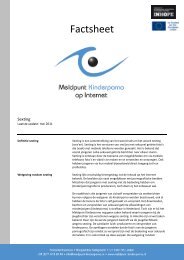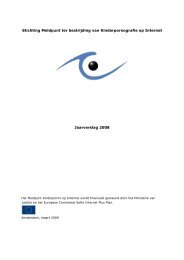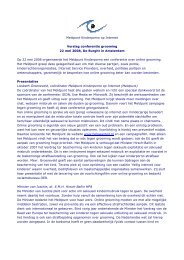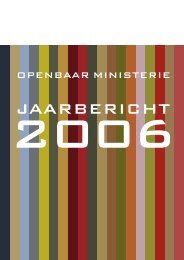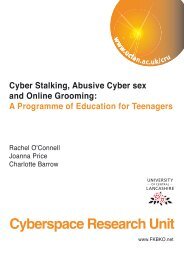sexual exploitation of children over the internet - Meldpunt ...
sexual exploitation of children over the internet - Meldpunt ...
sexual exploitation of children over the internet - Meldpunt ...
Create successful ePaper yourself
Turn your PDF publications into a flip-book with our unique Google optimized e-Paper software.
A recent proposal by NCMEC supports a dual approach <strong>of</strong> fur<strong>the</strong>ring lawenforcement investigations and shutting down <strong>the</strong> websites. NCMEC, which announced<strong>the</strong> initiative at <strong>the</strong> Subcommittee’s September 26, 2006 hearing, explained that <strong>the</strong>y areworking with law enforcement and <strong>the</strong> industry to devise a system that is similar to <strong>the</strong>U.K.’s notice and takedown model. Notably, this approach was suggested by NCMECafter <strong>the</strong> Committee expressed an interest in setting up a system in <strong>the</strong> U.S. similar to <strong>the</strong>IWF’s “notice and takedown” approach to child pornography websites. According toNCMEC’s proposal, law enforcement agents will first be notified <strong>of</strong> child pornographywebsites so that <strong>the</strong>y have <strong>the</strong> opportunity to investigate <strong>the</strong> website and ga<strong>the</strong>r evidence.Then, if <strong>the</strong> law enforcement agents agree, NCMEC will forward <strong>the</strong> Internet address for<strong>the</strong> website to <strong>the</strong> ISPs so that <strong>the</strong> ISPs may block <strong>the</strong> website on <strong>the</strong>ir system. Byinvolving law enforcement from <strong>the</strong> beginning, <strong>the</strong> NCMEC approach might avoid anissue faced by those systems that primarily rely on notice and takedown to put an end to<strong>the</strong> proliferation <strong>of</strong> online child pornography: child pornography websites move Internetaddresses constantly to avoid detection and, if subject to a takedown, simply move <strong>the</strong>ircontent to a new Internet address. In addition, peer-to-peer systems, ra<strong>the</strong>r than websites,are becoming a popular way to trade child pornography images because <strong>the</strong>se systemsmake it difficult for law enforcement agents to trace and intercept <strong>the</strong> transmission <strong>of</strong>images. A notice and takedown approach is largely ineffective against this type <strong>of</strong>technology.The cooperation and sharing <strong>of</strong> ideas among U.S. and international law enforcement,NCMEC, <strong>the</strong> IWF, and o<strong>the</strong>r international groups must continue so that <strong>the</strong> fight againstonline child pornography can be won. NCMEC’s recent notice and takedown proposal isa prime example <strong>of</strong> how law enforcement can improve its tools and methods by learningfrom <strong>the</strong> experience <strong>of</strong> o<strong>the</strong>r countries. The experience <strong>of</strong> foreign industry in preventingchild pornography can also be a resource for U.S. businesses. In <strong>the</strong> United Kingdom,British telecommunications companies and some mobile telephone companies thatprovide connectivity to <strong>the</strong> Internet have developed systems intended to prevent <strong>the</strong>ircustomers from connecting to child pornography websites.B. The Role <strong>of</strong> Internet Service Providers and Social NetworkingWebsites in Combating <strong>the</strong> Sexual Exploitation <strong>of</strong> Children Over<strong>the</strong> InternetIn order to examine <strong>the</strong> role <strong>of</strong> <strong>the</strong> U.S. Internet Service Provider industry in <strong>the</strong> fightagainst child pornography, <strong>the</strong> Subcommittee convened two days <strong>of</strong> hearings on June 27and 28, 2006 entitled “Making <strong>the</strong> Internet Safe for Kids: The Role <strong>of</strong> ISPs and SocialNetworking Sites.” The Internet Service Providers testifying at this hearing includedrepresentatives from America Online (“AOL”), Micros<strong>of</strong>t, Google, Yahoo, Earthlink,Comcast, and Verizon; <strong>the</strong> social networking websites included MySpace, Xanga, andFacebook. Commissioner Pamela Jones Harbour <strong>of</strong> <strong>the</strong> Federal Trade Commission, andDiego Ruiz, Deputy Chief, Office <strong>of</strong> Strategic Planning and Policy Analysis, <strong>of</strong> <strong>the</strong>Federal Communications Commission, also testified about <strong>the</strong> role <strong>of</strong> <strong>the</strong>ir agencies inregulating Internet companies.20





